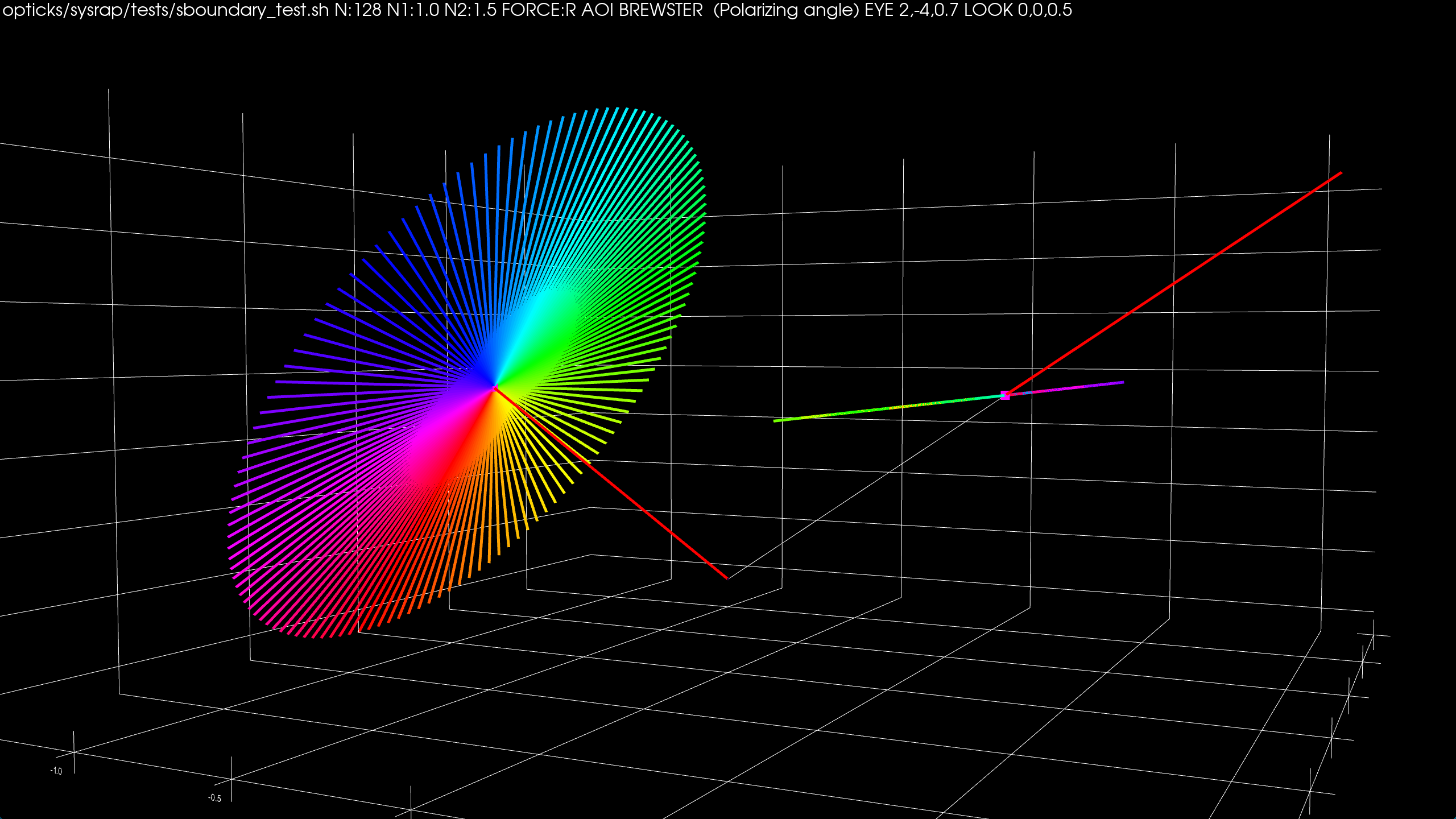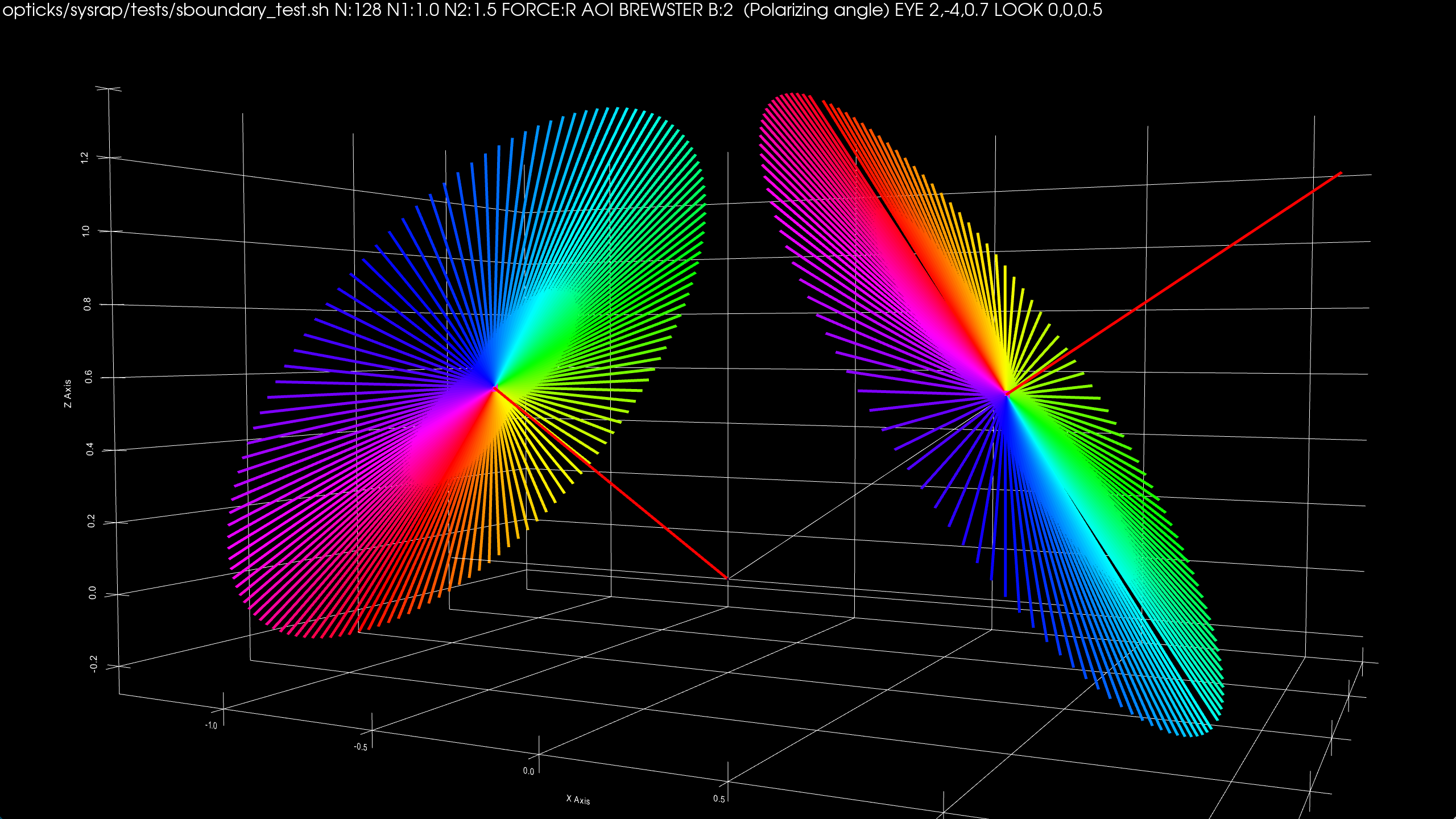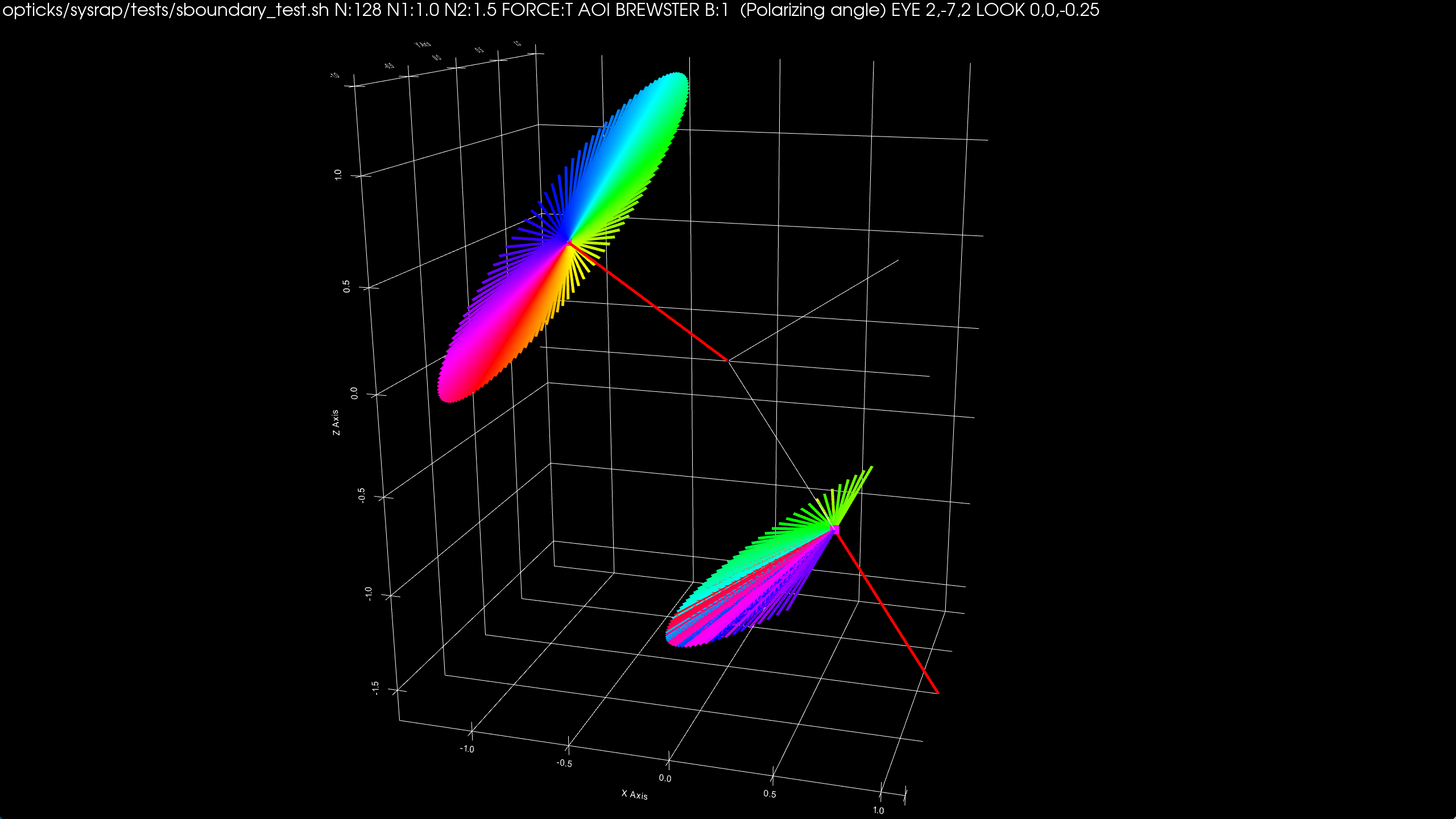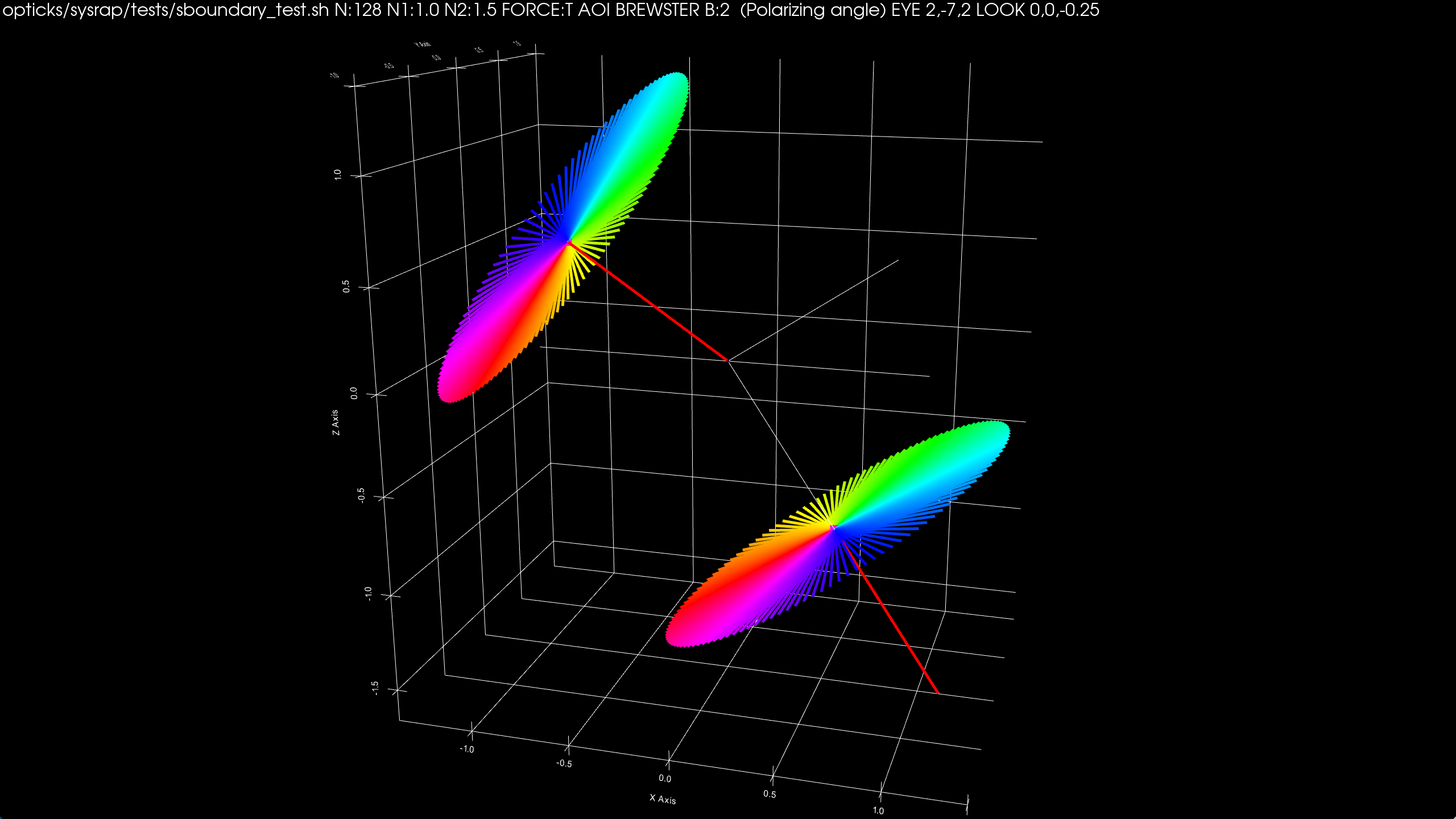Opticks + JUNO : PMT Geometry + Optical Model Progress
Opticks + JUNO : PMT Geometry + Optical Model Progress
Open source, https://bitbucket.org/simoncblyth/opticks
- Many Opticks + JUNO Geometry Bugs fixed : NO KNOWN ISSUES REMAIN
- Layr.h Multi-Layer TMM CPU/GPU header-only impl : VALIDATED
- junoPMTOpticalModel standalone tests reveal issues, all from FastSim use:
- over complex PMT geometry and Geant4 step histories
- LIVE BUGS: polarization and propagation time within PMT
- PLAN FIX : replace junoPMTOpticalModel FastSim with CustomG4OpBoundaryProcess:
- can fix above issues using a more standard approach
- simpler geometry, simpler simulation history, less code
- facilitates bringing PMT Optical Model to GPU within Opticks
- OTHER WORK : more direct Opticks geometry translation (AIM: massive code reduction)
- substantial progress U4Material/U4Surface/U4Solid/stree/snode/snd
Simon C Blyth, IHEP, CAS — 6 Feb 2023
JUNO + Opticks : Timeline, see Refs for more detail
Opticks Presentations, Refs
- 2022 Aug-Sep : Fixed geometry issues:
- JUNO : PMT, PMTMask overlaps
- Opticks : ellipsoid apex hole, thin cylinder, cone apex
- 2022 Oct-Nov : MultiFilmSimSvc -> GPU/CPU Layr.h
- 17 November 2022, JOC Meeting
- Show PMT geometry issues and fixes already merged
- Describe MultiFilmSimSvc -> GPU/CPU Layr.h
- opticks_20221117_mask_debug_and_tmm.html
- 2022 Dec : Standalone few-PMT junoPMTOpticalModel test:
- overcomplex : PMT geometry and Geant4 histories (inappropriate FastSim)
- LIVE BUGS : incorrect PMT reflect/refract polarization, incorrect propagation speed in PMT
- 20 December 2022, AFG Sim Meeting
- Demonstrated CustomG4OpBoundaryProcess can fix issues (using standalone few-PMT tests)
- my impression: General agreement to proceed with fix, Guofu convinced
- opticks_20221220_junoPMTOpticalModel_FastSim_issues_and_CustomG4OpBoundaryProcess_fix.html
- 2023 Jan : Start adapting above for use within junosw "monolith" by decoupling PMT data access
- low dependency PMT data access : PMTSimParamData (MERGE STALLED: Jan 17->Feb 3)
- OTHER WORK : more direct geometry translation : U4Material/U4Surface/U4Solid/stree/snode/snd
Details in above presentations + notes : https://bitbucket.org/simoncblyth/opticks/src/master/notes/progress.rst
JUNO + Opticks : Summary of Geometry Bug Fixes
JUNO ISSUES
NNVT : MaskTail impinges MaskVirtual
- junosw/-/issues/32
- FIXED : via gitlab MR
HAMA : BodySolid impinges MaskTail
- junosw/-/issues/33
- FIXED : via gitlab MR
- shifted mask, concentric with PMT ellipsoid
BirksConstant1 : 1,000,000x TOO BIG
- junosw/-/issues/24
- DsG4Scintillation not yielding any photons
- FIXED : typo in parameter
OPTICKS PRIM ISSUES
nmskSolidMask : ellipsoid hole at "apex" issue
- few per million "apex" rays find hole in ellipsoid
- manifests as spurious "waist" intersects
- FIXED : add zcut safety margin to CSG_ZSPHERE
nmskSolidMaskTail : very thin cylinder "lip" issues
- requires uncoincidence shift of subtractee
- BUT : even after uncoincide some spurious remain !
- BUG 1 : mis-translated as CSG_DISC, not CSG_CYLINDER
- BUG 2 : intersect precision loss for near-axial rays
- FIXED : reimplement CSG_CYLINDER with less FLOPS
nmskSolidMaskVirtual : cone precision + near-apex issues
- spurious sprinkle remains after uncoincide
- BUG 1 : CSG_CONE precision loss in one quadratic root
- BUG 2 : rays close to infinite cone apex yield spurious
- FIXED : CSG_CONE robust roots + fix bad assumption
https://simoncblyth.bitbucket.io/env/presentation/opticks_20221117_mask_debug_and_tmm.html
nmsk_nnvt_solids_STUVWXY_nnvt_virtualMask_Mask_overlap.png
NNVT : ONE overlap issue visible, MaskTail impinges MaskVirtual
(using ct.sh : Opticks CSG on CPU)
hmsk_hama_solids_STUVWXY_BodySolid_x_MaskTail.png
HAMA : ONE overlap issue, BodySolid impinges MaskTail
(using ct.sh : Opticks CSG on CPU)
hmsk_hama_solids_STUVWXY_zoom_impinge.png
HAMA : BodySolid impinges MaskTail (mct.sh)
hmsk_hama_solids_STUVWXY_after_bug_33_fix.png
HAMA : after bug 33 fix
Layr.h : simple GPU/CPU header-only re-impl. of MultiFilmSimSvc
junosw/Simulation/SimSvc/MultiFilmSimSvc
epsilon:MultiFilmSimSvc blyth$ find . -type f ./CMakeLists.txt ./python/MultiFilmSimSvc/__init__.py ./MultiFilmSimSvc/MultiFilmModel.h ./src/OpticalSystem.h ./src/Layer.h ./src/Material.h ./src/Layer.cc ## Layer, ThickLayer, ThinLayer ./src/Matrix.h ./src/OpticalSystem.cc ./src/MultiFilmModel.cc ./src/Material.cc ./src/Matrix.cc
CPU/GPU : using complex
#ifdef WITH_THRUST
using thrust::complex ; //GPU
#else
using std::complex ; //CPU
#endif
// same complex TMM math on CPU/GPU
template<typename T> struct Layr
{
T d, pad ; // d:thickness : zero means incoherent
#ifdef WITH_THRUST
thrust::complex n, st, ct, rs, rp, ts, tp ;
#else
std::complex n, st, ct, rs, rp, ts, tp ;
#endif
Matx S, P ;
};
template <typename T, int N> struct Stack
{
Layr<T> ll[N] ; // stack of N layers
Layr<T> comp ; // composite for the N layers
ART_<T> art ; // results eg A,R,T
Stack(T wl, T minus_cos_theta, const StackSpec<T>& ss);
};
https://github.com/simoncblyth/j/blob/main/Layr/Layr.h
- simple impl : compiles with nvcc/gcc for GPU/CPU
- using thrust::complex/std::complex
- YES : struct, arrays, templates, enum, constexpr
- NO : std::vector std::map std::string std::cout virtual meth.
- Layr.h reproduces MultiFilmSimSvc ART results
- works on both CPU and GPU
ALT: multi-GB "ART" textures (Yuxiang Hu) TODO: compare
LayrTest.{sh,cc,h,cu,py} : AOI scan with float/double on CPU/GPU ...
Impl: arrays of simple struct
- persist everything for every (aoi, wl) into .npy
- all layers, Fresnel coeff, matrix, ART
epsilon:Layr blyth$ ./LayrTest.sh ana
CFLayrTest
a : EGet : scan__EGet__cpu_thr_double
b : EGet : scan__EGet__cpu_thr_float
c : EGet : scan__EGet__gpu_thr_double
d : EGet : scan__EGet__gpu_thr_float
...
m : R12860 : scan__R12860__cpu_pom_double
n : R12860 : scan__R12860__cpu_thr_double
o : R12860 : scan__R12860__cpu_thr_float
p : R12860 : scan__R12860__gpu_thr_double
q : R12860 : scan__R12860__gpu_thr_float
In [1]: CF(m,q,0.05)
Out[1]:
CF(m,q,0.05) : scan__R12860__cpu_pom_double vs scan__R12860__gpu_thr_float
lls : 0.000442 : 0.000442 : -0.000414
comps : 0.000341 : 0.000341 : -6.17e-05
arts : 6.2e-05 : 6.2e-05 : -6.2e-05
pmtcat:R12860 tt:5 lt:q : j/Layr/LayrTest scan__R12860__gpu_thr_float ni 900 wl 440
+------------------------------+----------+----------+----------+----------+----------+
| R12860 arts\comps 0.05| m:cpd| n:ctd| o:ctf| p:gtd| q:gtf|
+==============================+==========+==========+==========+==========+==========+
| m:cpd| 0| 0.0003325| 0.000301| 0.0003325| 0.0003407|
+------------------------------+----------+----------+----------+----------+----------+ max difference of all param between scans
| n:ctd| 6.064e-05| 0| 4.829e-05| 7.445e-14| 4.829e-05|
+------------------------------+----------+----------+----------+----------+----------+
| o:ctf| 5.454e-05| 6.101e-06| 0| 4.829e-05| 3.977e-05|
+------------------------------+----------+----------+----------+----------+----------+
| p:gtd| 6.064e-05| 1.321e-14| 6.101e-06| 0| 4.829e-05|
+------------------------------+----------+----------+----------+----------+----------+
| q:gtf| 6.199e-05| 1.523e-06| 7.451e-06| 1.523e-06| 0|
+------------------------------+----------+----------+----------+----------+----------+
In [1]: ARTPlot(m, 0.05)
LayrTest_4_ARTQspx_R12860_4layer.png
S/P-Pol : perp./within plane
S/P Polarization : has huge effect on A,R,T in both directions : AOI > 90 is reversed stack
LayrTest_4_AQspx_R12860_4layer.png
4 : A
Absorption : large S/P-polarization difference in both directions
LayrTest_4_Rspx_R12860_4layer.png
4 : R
Only reflection at glancing incidence (90 deg) : large S/P-pol. difference for Vacuum->Pyrex
LayrTest_4_Tspx_R12860_4layer.png
4 : T
Pyrex->Vacuum : Above critical angle : no transmission, only reflect or absorb
Standalone few PMT test of Geometry and Optical Model
Standalone Advantages
- Fast development cycle, full control:
| https://github.com/simoncblyth/j/ |
| https://bitbucket.org/simoncblyth/opticks/ |
"CustomG4OpBoundaryProcess" FIX
- Layr.h for TMM calcs
- JPMT.h parameter access (not PMTSimParamSvc, PMTParamSvc)
opticks:u4/InstrumentedG4OpBoundaryProcess.cc
- Customized with CustomART.h
j:PMTFastSim Standalone PMT geometry and Optical Model
- https://github.com/simoncblyth/j/
- j:PMTFastSim/junoPMTOpticalModel.cc
- j:PMTFastSim/HamamatsuR12860PMTManager.cc
- N=0/1 natural geometry switch
Optical only Geant4 simulation, with full step point recording
N=0/1 ./U4SimulateTest.sh
Geant4 Simtrace intersection : 2D geometry plotting
N=0/1 ./U4SimtraceTest.sh
junoPMTOpticalModel Issues : All from using FastSim
CustomG4OpBoundaryProcess ?
- simple 2 volume (Pyrex+Vacuum) geometry
- standard G4OpBoundaryProcess reflect/refract/absorb/TIR
- much less code : reuse of standard Geant4
- easier Opticks on GPU : simpler, more standard
- no near-degenerate 1e-3 mm boundaries
- allows same geometry on CPU and GPU
- avoid history rewriting for comparisons
BUT : need to change very nasty Geant4 impl:
- G4OpBoundaryProcess::PostStepDoIt
- ugly monolith, rats nest of nested ifs
- Unpleasant to get familiar with
- Change palatable, using : CustomART.h
- Keep change separated, detailed validation vital
- Four volume PMT due to FastSim limitation
- Two volumes (Pyrex + Vacuum) would be natural
- Fake volumes yield many fake intersects
- Pyrex/Pyrex + Vacuum/Vacuum same material fakes
- complicates Geant4 step point history
- complicates comparison with Opticks
- Non-FastSim in PMT propagates at Pyrex (not Vacuum) speed
- FastSim->SlowSim transition misses speed fixup
- reflected + refracted polarization doesnt follow Geant4
- should follow G4OpBoundaryProcess, depending on S/P
- All issues stem from using FastSim (designed for regions)
- not good fit for 1 boundary (Pyrex/ARC/PHC/Vacuum)
Polarization on FresnelReflection/FresnelRefraction/TotalInternalReflection
inline sboundary::sboundary():
_E2_t(make_float2( 2.f*n1c1/(n1c1+n2c2) ,
2.f*n1c1/(n2c1+n1c2) )),// (ts,tp)
_E2_r(make_float2( _E2_t.x - 1.f ,
n2*_E2_t.y/n1 - 1.f )),// (rs,rp)
A_transverse(cross(p.mom, orient*normal)),
E1_perp(dot(p.pol, A_transverse)),
E1(make_float2(E1_perp,sqrtf(1.f-E1_perp*E1_perp)))),
E2_t(_E2_t*E1),RR(normalize(E2_r)),
E2_r(_E2_r*E1),TT(normalize(E2_t)),
{
p.mom = reflect
?
p.mom + 2.0f*c1*orient*normal
:
eta*(p.mom) + (eta*c1 - c2)*orient*normal
;
A_parallel = normalize(cross(p.mom, A_transverse));
p.pol =
( reflect ?
( tir ?
-p.pol + 2.f*EdotN*orient*normal
:
RR.x*A_transverse + RR.y*A_parallel
)
:
TT.x*A_transverse + TT.y*A_parallel
)
;
} // IMPL BASED ON + VALIDATED AGAINST GEANT4
Reflect/Refract : INCORRECT POLARIZATION
void junoPMTOpticalModel::Reflect()
{
dir -= 2.*(dir*norm)*norm;
pol -= 2.*(pol*norm)*norm;
}
void junoPMTOpticalModel::Refract()
{
dir = (real(_cos_theta4) -
_cos_theta1*_n1/_n4)*norm + (_n1/_n4)*dir;
pol = (pol-(pol*dir)*dir).unit();
}
G4OpBoundaryProcess polarization from:
- S/P Fresnel Coeff
- S/P Directions : out/in plane of incidence
Opticks : sysrap/sboundary.h qudarap/qsim.h follows G4, ===>
Derive Fresnel from Maxwell Boundary Conditions
- Fresnel Equations, Alexander I. Lvovsky
- Encylopedia of Optical Engineering (fresnel-eoe.pdf)
Compare Reflected Polarization Impls for Brewster Angle Incidence
- opticks/src/master/sysrap/tests/sboundary_test.sh : build, run, plot


| G4OpBoundaryProcess/qsim.h/sboundary.h : Only S-polarized survives | junoPMTOpticalModel::Reflect : very different |
- incident from left (-X), surface normal vertically upwards (+Z), intersection point in middle,
- Colored lines represent polarization directions of 128 photons before and after Reflection
- Reflected using sboundary.h (validated against G4OpBoundaryProcess)
- Compared with sboundary.h:alt_pol that duplicates junoPMTOpticalModel::Reflect
Brewster (or polarizing) incident angle th1 : tan(th1) = n2/n1 ; th1 + th2 = pi/2
Compare Refracted Polarization Impls for Brewster Angle Incidence
- opticks/src/master/sysrap/tests/sboundary_test.sh : build, run, plot


| G4OpBoundaryProcess/qsim.h/sboundary.h : partial pol | junoPMTOpticalModel::Refract : not partially pol |
- incident from left (-X), surface normal vertically upwards (+Z), intersection point in middle,
- Colored lines represent polarization directions of 128 photons before and after Refraction
- Refracted using sboundary.h (compared with alt_pol that duplicates junoPMTOpticalModel::Refract )
hamaLogicalPMT_natural.png
Natural 2-volume PMT (Pyrex + Vacuum) : NOT COMPATIBLE WITH FastSim
hamaLogicalPMT_fake.png
body hidden under inner1 inner2
body is FastSim envelope volume
CURRENT : Unnatural 4-volume PMT (Pyrex+Pyrex+Vacuum+Vacuum) => Half Fake
junoPMTOpticalModel FastSim : Fake Volumes -> Contorted ModelTrigger
Current MultiLayer POM
+---------------pmt-Pyrex----------------+ | | | | | +----body-Pyrex-(FSim-env)---+ | | | +------------------------+ | | | | | | | | | | | | | | | | | inner1-Vacuum |-| | | | | |1e-3 | | | | | | | | | +~~coincident~face~~~~~~~+ | | | | | | | | | | | | | | | | | inner2-Vacuum | | | | | | | | | | | | | | | | | +------------------------+ | | | +----------------------------+ | | | | | +----------------------------------------+
- ModelTrigger : unnatural trig @ Vac/Vac bnd.
- DoIt : shift to edge, for ART calc
- only m_mirror_opsurf (inner2<->body) "active"
80 G4bool junoPMTOpticalModel::ModelTrigger(const G4FastTrack &fastTrack)
81 { // Contorted as "pre-trigger" on where next
83 if(fastTrack.GetPrimaryTrack()->GetVolume() == _inner2_phys){
84 return false;
85 }
...
89 pos = fastTrack.GetPrimaryTrackLocalPosition();
90 dir = fastTrack.GetPrimaryTrackLocalDirection();
94
95 if(fastTrack.GetPrimaryTrack()->GetVolume() == _inner1_phys){
96 whereAmI = kInVacuum;
97 }else{
98 whereAmI = kInGlass;
99 }
100
101 if(whereAmI == kInGlass){
102 dist1 = _inner1_solid->DistanceToIn(pos, dir);
103 dist2 = _inner2_solid->DistanceToIn(pos, dir);
104
105 if(dist1 == kInfinity){
106 return false;
107 }else if(dist1>dist2){
108 return false;
109 }else{
110 return true;
111 }
112 }else{
113 dist1 = _inner1_solid->DistanceToOut(pos, dir);
114 dist2 = _inner2_solid->DistanceToIn(pos, dir);
115
116 if(dist2 == kInfinity){
117 return true;
118 }
119 }
120 return false;
121 }
junoPMTOpticalModelSimple : Natural Geometry -> Simple ModelTrigger
Simplified MultiLayer POM
+---------------pmt-Pyrex----------------+ | | | | | | | +~inner~Vacuum~(FSim~env)+ | | ! ! | | ! ! | | ! ! | | ! ! | | ! ! | | + + | | | | | | | | | | | | | | | | | | | | | | +------------------------+ | | | | | | | +----------------------------------------+
- ModelTrigger : z>0 : no unnatural trig
- override mirror_opsurf (inner<->pmt) @ z > 0
- simpler DoIt : no geom. queries, no shifting
G4bool junoPMTOpticalModelSimple::ModelTrigger(
const G4FastTrack &fastTrack)
{
// Simple + Cheap due to natural geometry
return fastTrack.GetPrimaryTrackLocalPosition().z() > 0. ;
}
https://github.com/simoncblyth/j/blob/main/PMTFastSim/junoPMTOpticalModelSimple.cc
junoPMTOpticalModelSimple : Natural Geometry -> Simple DoIt
Simplified MultiLayer POM
+---------------pmt-Pyrex----------------+ | | | | | | | +~inner~Vacuum~(FSim~env)+ | | ! ! | | ! ! | | ! ! | | ! ! | | ! ! | | + + | | | | | | | | | | | | | | | | | | | | | | +------------------------+ | | | | | | | +----------------------------------------+
- ModelTrigger : z>0 : no unnatural trig
- override mirror_opsurf (inner<->pmt) @ z > 0
- simpler DoIt : no geom. queries, no shifting
void junoPMTOpticalModelSimple::DoIt(const G4FastTrack& fastTrack,
G4FastStep &fastStep)
{
G4double energy = fastTrack.GetPrimaryTrack()->GetKineticEnergy();
wavelength_nm = twopi*hbarc/energy/nm ;
position = fastTrack.GetPrimaryTrackLocalPosition();
direction = fastTrack.GetPrimaryTrackLocalDirection();
polarization = fastTrack.GetPrimaryTrackLocalPolarization();
G4VSolid* envelope_solid = fastTrack.GetEnvelopeSolid();
surface_normal = envelope_solid->SurfaceNormal(position);
minus_cos_theta = direction*surface_normal ;
whereAmI = minus_cos_theta < 0. ? kInGlass : kInVacuum ;
StackSpec spec ;
// ... skip : collect refractive indices, thickness into spec ...
Stack stack( wavelength_nm, minus_cos_theta, spec );
Stack stackNormal(wavelength_nm, -1. , spec );
// ...
}
- Simple : BUT NOT WORKABLE
- Cannot stop: G4OpBoundaryProcess
- REAL REASON FOR THE FAKE VOLUMES
- Workaround limitations of Geant4 FastSim
Pivot to CustomG4OpBoundaryProcess For PMT Optical Model ?
Custom Boundary POM
+---------------pmt-Pyrex----------------+ | | | | | | | +~inner~Vacuum~~~~~~~~~~~+ | | ! ! | | ! ! | | ! ! | | ! ! | | ! ! | | + + | | | | | | | | | | | | | | | | | | | | | | +------------------------+ | | | | | | | +----------------------------------------+
OpSurfaceName[0] == '@'
- local_z>0 : does MultiLayer ART calc
- !(local_z>0) : standard mirror_opsurf
- Cannot use natural geometry with FastSim
- SO: CustomG4OpBoundaryProcess
Custom Boundary Process : Advantages
- standard Geant4 polarization, propagation
- less code, simpler code
- natural geometry, avoiding fakes
- simpler Geant4 step history (no fakes)
- same geometry on GPU+CPU, easier Opticks validation
- half the geometry objects to model PMT (4->2)
| Current FastSim POM | 4 Solid, 4 LV, 4 PV |
| Custom Boundary POM | 2 Solid, 2 LV, 2 PV |
Disadvantages
- maintain custom G4OpBoundaryProcess
- updating Geant4 may require care (depending on changes)
Advantages far outweigh disadvantages
u4/CustomART.h : include into CustomG4OpBoundaryProcess.cc
CustomART::maybe_doIt
inline char CustomART::maybe_doIt(
const char* OpticalSurfaceName,
const G4Track& aTrack, const G4Step& aStep )
{
if( OpticalSurfaceName == nullptr ||
OpticalSurfaceName[0] != '@') return 'N' ;
const G4AffineTransform& transform =
aTrack.GetTouchable()
->GetHistory()->GetTopTransform();
G4ThreeVector localPoint =
transform.TransformPoint(theGlobalPoint);
if(localPoint.z() <= 0) return 'Z' ;
return doIt(aTrack, aStep) ;
}
doIt TMM calc, runs only for:
- OpticalSurfaceName[0]=='@' && zlocal > 0
- -> Transmittance, Reflectivity, Efficiency
- TMM calc using Layr.h multi-layer Stack
#include "IPMTAccessor.h"
#include "Layr.h"
#include "U4Touchable.h"
struct CustomART
{
const IPMTAccessor* accessor ; // JPMT.h OR PMTAccessor.h
G4double& theTransmittance ; // doIt sets these
G4double& theReflectivity ;
G4double& theEfficiency ;
const G4ThreeVector& theGlobalPoint ;
const G4ThreeVector& OldMomentum ;
const G4ThreeVector& OldPolarization ;
const G4ThreeVector& theRecoveredNormal ;
const G4double& thePhotonMomentum ;
CustomART(
const IPMTAccessor* accessor,
G4double& theTransmittance,
G4double& theReflectivity,
G4double& theEfficiency,
const G4ThreeVector& theGlobalPoint,
const G4ThreeVector& OldMomentum,
const G4ThreeVector& OldPolarization,
const G4ThreeVector& theRecoveredNormal,
const G4double& thePhotonMomentum
);
char maybe_doIt(const char* OpticalSurfaceName,
const G4Track& aTrack, const G4Step& aStep );
char doIt(const G4Track& aTrack, const G4Step& aStep );
};
opticks/src/master/u4/CustomART.h
hamaLogicalPMTWrapLV_full_history.png
TO BT BT BT BT SR SR BT BR BR BT SR SR SR BT BR BT SR BT SA Lots of fakes
00 01 [02] 03 [04] 05 06 [07] 08 09 [10] 11 12 13 [14] 15 [16] 17 [18] 19 (7/20 Fake)
hamaLogicalPMTWrapLV_natural.png
TO BT BT SR SR BR BR SR SR SR BR SR BR SR SA 00 01 02 03 04 05 06 07 08 09 10 11 12 13 14 Simpler history, no fakes 00 01 03 05 06 08 09 11 12 13 15 17 19
Compare "big bouncer" position, time between N=0,1 (1)
u4t ; ./U4SimulateTest.sh cf
In [12]: np.c_[ar[:,0],np.arange(len(ar)),br[:,0]]
Out[12]:
array([[-113. , 0. , 200. , 0. , 0. , -113. , 0. , 200. , 0. ],
[-113. , 0. , 170.163, 0.137, 1. , -113. , 0. , 170.163, 0.137],
[-112.83 , 0. , 164.918, 0.164, 2. , -112.83 , 0. , 164.917, 0.164],
[-112.83 , 0. , 164.917, 0.164, 3. , -156.577, 0. , -148.846, 1.22 ],
[-135.824, 0. , 0. , 1.012, 4. , -95. , 0. , -104.211, 1.474],
[-156.577, 0. , -148.846, 1.778, 5. , -248.807, 0. , 7.28 , 2.108],
[ -95. , 0. , -104.211, 2.166, 6. , 53.206, 0. , 180.727, 3.269],
[-238.764, 0. , -0. , 3.071, 7. , 245.605, 0. , -35.443, 4.235],
[-248.807, 0. , 7.28 , 3.112, 8. , 95. , 0. , -99.428, 4.781],
[ 53.205, 0. , 180.727, 4.274, 9. , 177.724, 0. , -134.574, 5.08 ],
[ 214.06 , 0. , 0. , 5.507, 10. , 141.059, 0. , 152.451, 6.046],
[ 245.605, 0. , -35.443, 5.749, 11. , -239.66 , 0. , -55.195, 7.492],
[ 95. , 0. , -99.428, 6.583, 12. , 237.91 , 0. , 54.597, 9.127],
[ 177.724, 0. , -134.574, 7.041, 13. , 50. , 0. , -63.74 , 9.867],
[ 160.533, 0. , 0. , 7.732, 14. , 58.352, 0. , -69. , 9.9 ],
[ 141.059, 0. , 152.451, 8.245, 15. , 0. , 0. , 0. , 0. ],
[-138.46 , 0. , 0. , 9.867, 16. , 0. , 0. , 0. , 0. ],
[-239.66 , 0. , -55.195, 10.455, 17. , 0. , 0. , 0. , 0. ],
[ 0.427, 0. , 0. , 11.71 , 18. , 0. , 0. , 0. , 0. ],
[ 237.91 , 0. , 54.596, 12.523, 19. , 0. , 0. , 0. , 0. ],
[ 0. , 0. , 0. , 0. , 20. , 0. , 0. , 0. , 0. ],
[ 0. , 0. , 0. , 0. , 21. , 0. , 0. , 0. , 0. ],
[ 0. , 0. , 0. , 0. , 22. , 0. , 0. , 0. , 0. ],
[ 0. , 0. , 0. , 0. , 23. , 0. , 0. , 0. , 0. ],
| ar | a.record[PID] | N=0 current geom | degenerate and fake intersect points |
| bb | b.record[PID] | N=1 natural geom | less points, simpler history |
Need point-to-point mapping to compare
Compare "big bouncer" position, time between N=0,1 (2)
u4t ; ./U4SimulateTest.sh cf
In [2]: b2a ## point-to-point mapping to skip a fakes
Out[2]: array([ 0, 1, 3, 5, 6, 8, 9, 11, 12, 13, 15, 17, 19])
In [4]: abr = np.c_[ar[b2a,0],br[:len(b2a),0],ar[b2a,0]-br[:len(b2a),0]] ; abr
Out[4]:
array([[-113. , 0. , 200. , 0. , -113. , 0. , 200. , 0. , 0. , 0. , 0. , 0. ],
[-113. , 0. , 170.163, 0.137, -113. , 0. , 170.163, 0.137, 0. , 0. , 0. , 0. ],
[-112.83 , 0. , 164.917, 0.164, -112.83 , 0. , 164.917, 0.164, 0. , 0. , 0. , -0. ],
[-156.577, 0. , -148.846, 1.778, -156.577, 0. , -148.846, 1.22 , -0. , 0. , 0. , 0.558],
[ -95. , 0. , -104.211, 2.166, -95. , 0. , -104.211, 1.474, 0. , 0. , 0. , 0.692],
[-248.807, 0. , 7.28 , 3.112, -248.807, 0. , 7.28 , 2.108, 0. , 0. , -0. , 1.004],
[ 53.205, 0. , 180.727, 4.274, 53.206, 0. , 180.727, 3.269, -0. , 0. , 0. , 1.004],
[ 245.605, 0. , -35.443, 5.749, 245.605, 0. , -35.443, 4.235, 0. , 0. , 0. , 1.514],
[ 95. , 0. , -99.428, 6.583, 95. , 0. , -99.428, 4.781, 0. , 0. , 0. , 1.802],
[ 177.724, 0. , -134.574, 7.041, 177.724, 0. , -134.574, 5.08 , 0. , 0. , 0. , 1.96 ],
[ 141.059, 0. , 152.451, 8.245, 141.059, 0. , 152.451, 6.046, -0. , 0. , 0. , 2.199],
[-239.66 , 0. , -55.195, 10.455, -239.66 , 0. , -55.195, 7.492, 0. , 0. , 0. , 2.963],
[ 237.91 , 0. , 54.596, 12.523, 237.91 , 0. , 54.597, 9.127, 0. , 0. , -0. , 3.397]], dtype=float32)
Positions match closely, some times are way off
Compare "big bouncer" position, time, dist, speed between N=0,1
rvtime_ = lambda r:np.diff(r[:,0,3])
rvstep_ = lambda r:np.diff(r[:,0,:3],axis=0 )
rvdist_ = lambda r:np.sqrt(np.sum(rvstep_(r)*rvstep_(r),axis=1))
rvspeed_ = lambda r:rvdist_(r)/rvtime_(r)
In [14]: np.c_[rvtime_(ar[b2a]), rvtime_(br[:len(b2a)]),
rvdist_(ar[b2a]), rvdist_(br[:len(b2a)]),
rvspeed_(ar[b2a]),rvspeed_(br[:len(b2a)])]
Out[14]:
array([[ 0.137, 0.137, 29.837, 29.837, 218.038, 218.038], ## Water
[ 0.027, 0.027, 5.249, 5.249, 196.216, 196.215], ## Pyrex
[ 1.615, 1.057, 316.798, 316.798, 196.215, 299.792], ## Vacuum
[ 0.388, 0.254, 76.053, 76.053, 196.215, 299.792],
[ 0.946, 0.634, 189.965, 189.965, 200.744, 299.792], ## comb. of Vacuum and Pyrex speeds, split at Fake
[ 1.162, 1.162, 348.275, 348.275, 299.792, 299.792],
[ 1.475, 0.965, 289.392, 289.392, 196.215, 299.792],
[ 0.834, 0.546, 163.634, 163.634, 196.215, 299.792],
[ 0.458, 0.3 , 89.881, 89.881, 196.215, 299.792],
[ 1.204, 0.965, 289.357, 289.357, 240.315, 299.792], ## comb. of Vacuum and Pyrex speeds, split at Fake
[ 2.21 , 1.447, 433.663, 433.663, 196.215, 299.792],
[ 2.068, 1.635, 490.027, 490.027, 236.919, 299.792]], dtype=float32)
| N=0 | Pyrex speed within PMT Vacuum | FastSim->SlowSim transitions miss speed setup ? |
| N=1 | Always Vacuum speed in Vacuum | All standard Geant4 with customized G4OpBoundaryProcess |
hamaLogicalPMT_two_pmt_geom.png
hamaLogicalPMT_two_pmt_cf.png
Low dependency access to PMT data (26x faster)
Why Low Dependency Access ?
- CODING BEST PRACTICE
- less deps -> more useful code
- test separate from the "monolith"
- development cycle < 1 s (vs minutes)
- serialization with NP.hh,NPFold.h
- https://github.com/simoncblyth/np/
- 0-deps (hdr-only) -> PMT data anywhere
QE scan over 100 energy points, all PMTs
get_pmtid_qe( pmtid, en );
| IPMTSimParamSvc | 7.70 s |
| PMTSimParamData | 0.30 s |
| IPMTSimParamSvc/PMTSimParamData | 26.10 |
- exactly same results, 26x faster
| junosw/-/merge_requests/126 MERGED AFTER ~3 WEEKS |
| junosw/-/issues/66 |
| junosw/-/tree/blyth-66-low-dependency-PMT-data-access |
- PMTSimParamSvc and PMTParamSvc
- => too many deps for CustomG4OpBoundaryProcess
- hdrs for collecting data are irrelevant to access
- -> separate data struct from Svc
- header-only impl : PMTSimParamData PMTParamData
- _PMTSimParamData : serialization save/load
- reference data struct from Svc
- minimal changes to Svc, API
- consistency guaranteed
- no change with diff src : file, DB, Frontier
- speedup not the motivation, BUT 26x faster by:
- calc qe_scale ONCE, not for every photon
- large pmtid std::map -> std::vector
U4Tree.h/stree.h : Direct Geometry Translation
Current Approach : extg4 translated
| Geant4 -> GGeo -> CSG |
- Full intermediate GGeo model
- GMaterial/GMaterialLib/GSurfaceLib/...
- GMergedMesh/GMesh
- nnode/NCSG/...
- (lots of code)
DRASTIC CODE REDUCTION NEAR
- ~6 pkgs, literally hundreds of classes/structs
| Geant4 -> U4Tree.h/stree.h -> CSG |
- Minimal intermediate stree.h model
- stree.h : n-ary tree of snode volumes
- scsg.hh : n-ary trees of snd constituent solids
- (much less code)
|
| stree/snode/scsg/snd -> CSGFoundry/CSGSolid/CSGPrim/CSGNode |
Next Steps : Custom Boundary + Natural Geometry Branch
junosw : Natural PMT Geometry Branch
- almost all standalone tested already, need to bring into junosw monolith
- need switch : FastSim/standard-Sim, natural geometry, custom boundary
| Primary | Support |
|---|---|
| CustomG4OpBoundaryProcess CustomART.h Layr.h | PMTSimParamData (merged in MR 126) PMTAccessor/IPMTAccessor (j/Layr) HamamatsuR12860PMTManager NNVTMCPPMTManager |
Opticks : Custom boundary equivalent
- PMTSimParamData PMTAccessor -> GPU
- natural geometry => easier to validate (no fakes)
- standard propagation + polarization => easier (already implemented qudarap/qsim.h )